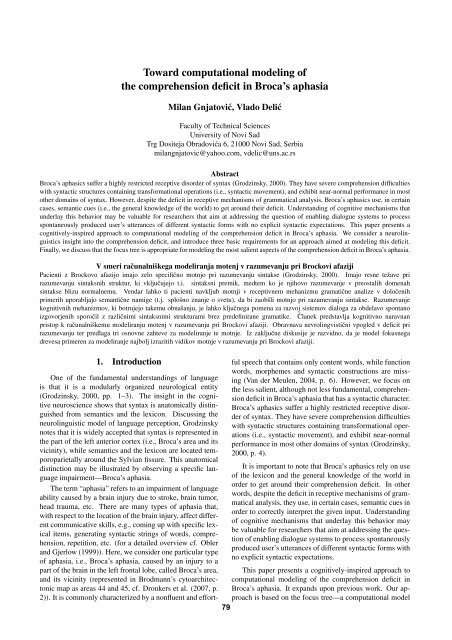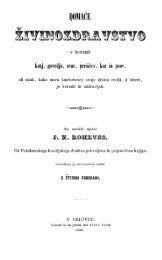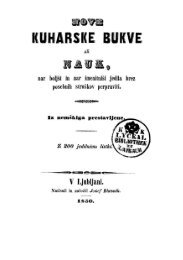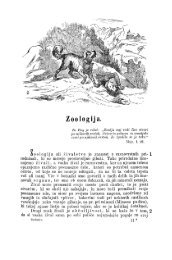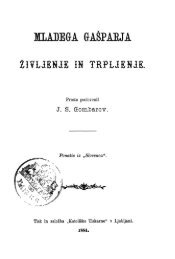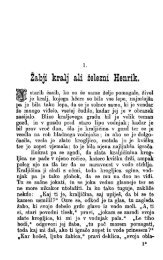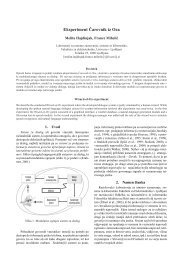Proceedings - Natural Language Server - IJS
Proceedings - Natural Language Server - IJS
Proceedings - Natural Language Server - IJS
You also want an ePaper? Increase the reach of your titles
YUMPU automatically turns print PDFs into web optimized ePapers that Google loves.
Toward computational modeling of<br />
the comprehension deficit in Broca’s aphasia<br />
Milan Gnjatović, Vlado Delić<br />
Faculty of Technical Sciences<br />
University of Novi Sad<br />
Trg Dositeja Obradovića 6, 21000 Novi Sad, Serbia<br />
milangnjatovic@yahoo.com, vdelic@uns.ac.rs<br />
Abstract<br />
Broca’s aphasics suffer a highly restricted receptive disorder of syntax (Grodzinsky, 2000). They have severe comprehension difficulties<br />
with syntactic structures containing transformational operations (i.e., syntactic movement), and exhibit near-normal performance in most<br />
other domains of syntax. However, despite the deficit in receptive mechanisms of grammatical analysis, Broca’s aphasics use, in certain<br />
cases, semantic cues (i.e., the general knowledge of the world) to get around their deficit. Understanding of cognitive mechanisms that<br />
underlay this behavior may be valuable for researchers that aim at addressing the question of enabling dialogue systems to process<br />
spontaneously produced user’s utterances of different syntactic forms with no explicit syntactic expectations. This paper presents a<br />
cognitively-inspired approach to computational modeling of the comprehension deficit in Broca’s aphasia. We consider a neurolinguistics<br />
insight into the comprehension deficit, and introduce three basic requirements for an approach aimed at modeling this deficit.<br />
Finally, we discuss that the focus tree is appropriate for modeling the most salient aspects of the comprehension deficit in Broca’s aphasia.<br />
V smeri računalniˇskega modeliranja motenj v razumevanju pri Brockovi afaziji<br />
Pacienti z Brockovo afazijo imajo zelo specifično motnjo pri razumevanju sintakse (Grodzinsky, 2000). Imajo resne teˇzave pri<br />
razumevanju sintaksnih struktur, ki vključujejo t.i. sintaksni premik, medtem ko je njihovo razumevanje v preostalih domenah<br />
sintakse blizu normalnemu. Vendar lahko ti pacienti navkljub motnji v receptivnem mehanizmu gramatične analize v določenih<br />
primerih uporabljajo semantične namige (t.j. sploˇsno znanje o svetu), da bi zaobˇsli motnjo pri razumevanju sintakse. Razumevanje<br />
kognitivnih mehanizmov, ki botrujejo takemu obnaˇsanju, je lahko ključnega pomena za razvoj sistemov dialoga za obdelavo spontano<br />
izgovorjenih sporočil z različnimi sintaksnimi strukturami brez predefinirane gramatike. Članek predstavlja kognitivno naravnan<br />
pristop k računalniˇskemu modeliranju motenj v razumevanju pri Brockovi afaziji. Obravnava nevrolingvistični vpogled v deficit pri<br />
razumevanju ter predlaga tri osnovne zahteve za modeliranje te motnje. Iz zaključne diskusije je razvidno, da je model fokusnega<br />
drevesa primeren za modeliranje najbolj izrazitih vidikov motnje v razumevanju pri Brockovi afaziji.<br />
1. Introduction<br />
One of the fundamental understandings of language<br />
is that it is a modularly organized neurological entity<br />
(Grodzinsky, 2000, pp. 1–3). The insight in the cognitive<br />
neuroscience shows that syntax is anatomically distinguished<br />
from semantics and the lexicon. Discussing the<br />
neurolinguistic model of language perception, Grodzinsky<br />
notes that it is widely accepted that syntax is represented in<br />
the part of the left anterior cortex (i.e., Broca’s area and its<br />
vicinity), while semantics and the lexicon are located temporoparietally<br />
around the Sylvian fissure. This anatomical<br />
distinction may be illustrated by observing a specific language<br />
impairment—Broca’s aphasia.<br />
The term “aphasia” refers to an impairment of language<br />
ability caused by a brain injury due to stroke, brain tumor,<br />
head trauma, etc. There are many types of aphasia that,<br />
with respect to the location of the brain injury, affect different<br />
communicative skills, e.g., coming up with specific lexical<br />
items, generating syntactic strings of words, comprehension,<br />
repetition, etc. (for a detailed overview cf. Obler<br />
and Gjerlow (1999)). Here, we consider one particular type<br />
of aphasia, i.e., Broca’s aphasia, caused by an injury to a<br />
part of the brain in the left frontal lobe, called Broca’s area,<br />
and its vicinity (represented in Brodmann’s cytoarchitectonic<br />
map as areas 44 and 45, cf. Dronkers et al. (2007, p.<br />
2)). It is commonly characterized by a nonfluent and effort-<br />
ful speech that contains only content words, while function<br />
words, morphemes and syntactic constructions are missing<br />
(Van der Meulen, 2004, p. 6). However, we focus on<br />
the less salient, although not less fundamental, comprehension<br />
deficit in Broca’s aphasia that has a syntactic character.<br />
Broca’s aphasics suffer a highly restricted receptive disorder<br />
of syntax. They have severe comprehension difficulties<br />
with syntactic structures containing transformational operations<br />
(i.e., syntactic movement), and exhibit near-normal<br />
performance in most other domains of syntax (Grodzinsky,<br />
2000, p. 4).<br />
It is important to note that Broca’s aphasics rely on use<br />
of the lexicon and the general knowledge of the world in<br />
order to get around their comprehension deficit. In other<br />
words, despite the deficit in receptive mechanisms of grammatical<br />
analysis, they use, in certain cases, semantic cues in<br />
order to correctly interpret the given input. Understanding<br />
of cognitive mechanisms that underlay this behavior may<br />
be valuable for researchers that aim at addressing the question<br />
of enabling dialogue systems to process spontaneously<br />
produced user’s utterances of different syntactic forms with<br />
no explicit syntactic expectations.<br />
This paper presents a cognitively-inspired approach to<br />
computational modeling of the comprehension deficit in<br />
Broca’s aphasia. It expands upon previous work. Our approach<br />
is based on the focus tree—a computational model<br />
79


